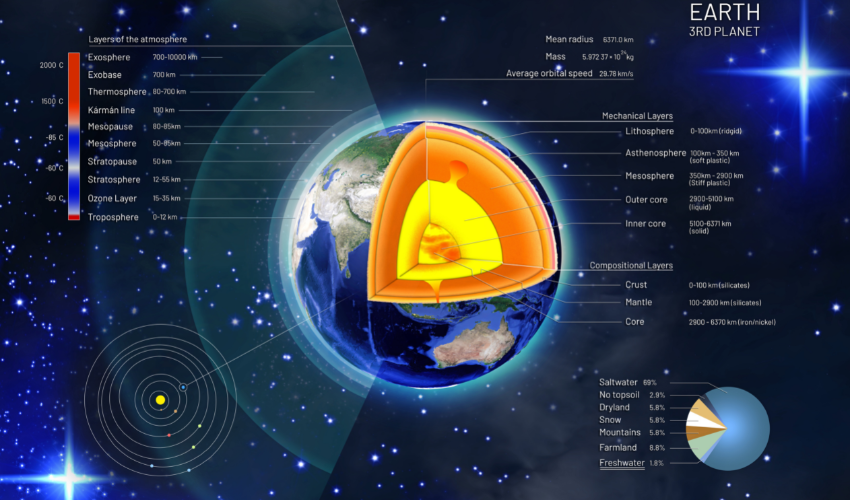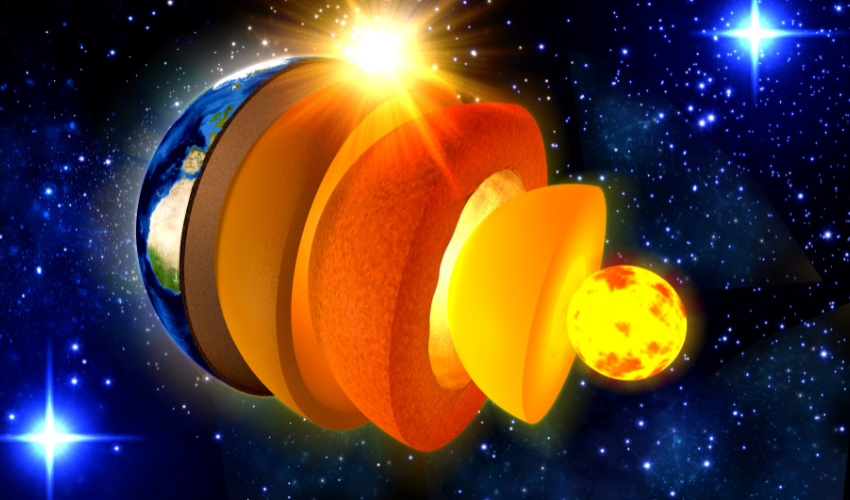The Earth’s crust is the outermost and thinnest layer of the Earth. It plays a crucial role in the planet’s geological and environmental processes. It is the layer where life exists and where most of our natural resources, such as minerals, metals, and energy sources, are found. Understanding the Earth’s crust is fundamental to comprehend the formation of the planet, the occurrence of natural disasters, and the distribution of resources. In this article, we will explore what the Earth’s crust is, its composition, features, functions, and significance.
What is Earth’s Crust?
The Earth’s crust is the outermost solid layer of the Earth’s surface, which ranges from 5 to 75 km (3 to 46 miles) thick. It is composed of a variety of rocks, minerals, and soils, including granites, basalts, sandstones, and shales. The crust is divided into two major types: the continental crust and the oceanic crust. The continental crust is thicker, less dense, and more complex than the oceanic crust, which is denser and made up of basaltic rocks.
Composition of Earth’s Crust

The Earth’s crust is composed of different elements, including oxygen, silicon, aluminum, iron, calcium, sodium, potassium, and magnesium. These elements combine to form minerals, such as quartz, feldspar, mica, and calcite, which are the building blocks of rocks. The crust’s composition varies depending on its location, age, and geological history. For example, the continental crust is richer in aluminum and silicon, while the oceanic crust is more abundant in iron and magnesium.
Features of Earth’s Crust
The Earth’s crust has various features, including mountains, valleys, plateaus, and oceans. These features are the result of the movement and interaction of tectonic plates, which are large blocks of the Earth’s crust that move over the mantle. The tectonic plates can converge, diverge, or slide past each other. This creates different landforms and geological phenomena, such as earthquakes, tsunamis. The crust is also home to various geological formations, such as faults, folds, and igneous intrusions, which provide evidence of the Earth’s history and geological processes.
Functions of Earth’s Crust
The Earth’s crust plays several important functions, including:
- Providing a habitat for life: The crust is the only layer of the Earth that supports life. It is home to various organisms, including plants, animals, and humans.
- Protecting the mantle: The crust acts as a protective layer for the mantle. It is the layer beneath the crust and is composed of molten rock.
- Providing resources: The crust contains a variety of natural resources, such as minerals, metals, and energy sources. They are essential for human development and progress.
- Regulating the climate: The crust’s landforms, such as mountains and oceans, play a crucial role in regulating the Earth’s climate. They affect the distribution of heat and moisture.
FAQs
How was the Earth’s crust formed?
It was formed through a process called differentiation, which occurred about 4.6 billion years ago. During this process, the molten rock that made up the early Earth separated into different layers based on their density. The less dense materials rose to the surface, forming the crust.
How thick is the Earth’s crust?
It is between 5 and 75 km (3 to 46 miles) thick, depending on its location.
What is the difference between the continental and oceanic crust?
The continental crust is thicker, less dense, and more complex than the oceanic crust, which is denser and made up of basaltic rocks.
What are tectonic plates?
Tectonic plates are large blocks of the Earth’s crust that move over the mantle. They can converge, diverge, or slide past each other, creating different landforms and geological phenomena.
What are some examples of natural resources found in the Earth’s crust?
Natural resources found in the Earth’s crust include minerals, metals, and energy sources, such as coal, oil, natural gas, gold, silver, and copper.
Conclusion
The Earth’s crust is a fundamental layer of the Earth that plays a vital role in the planet’s geological and environmental processes. It is the layer where life exists, and where most of our natural resources are found. Understanding the Earth’s crust is crucial to comprehend the formation of the planet, the occurrence of natural disasters, and the distribution of resources. By exploring its composition, features, functions, and significance, we can gain a deeper appreciation of the Earth and its intricate systems.























